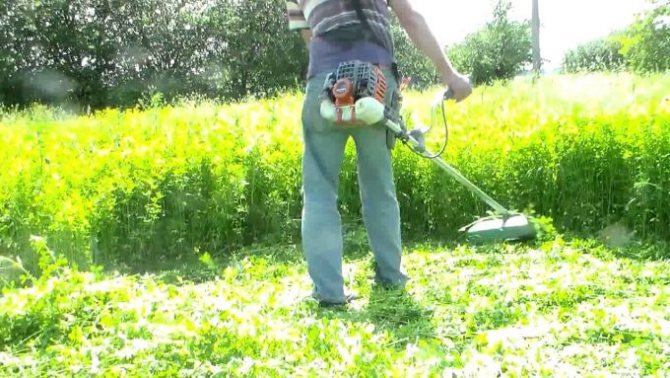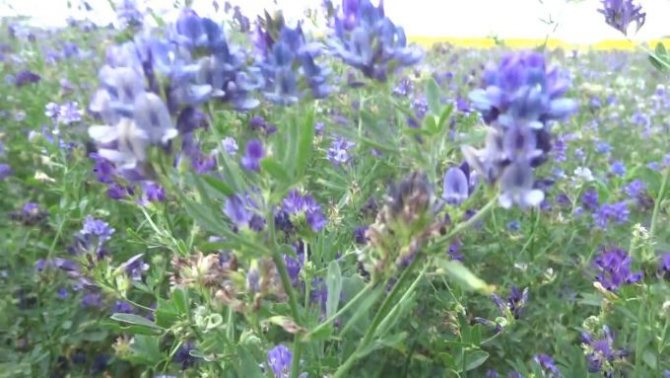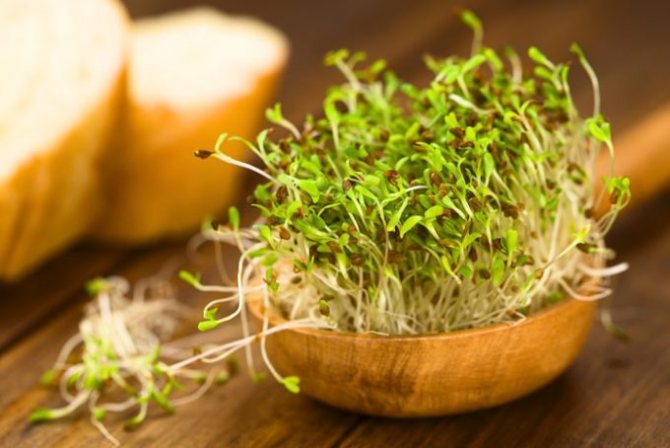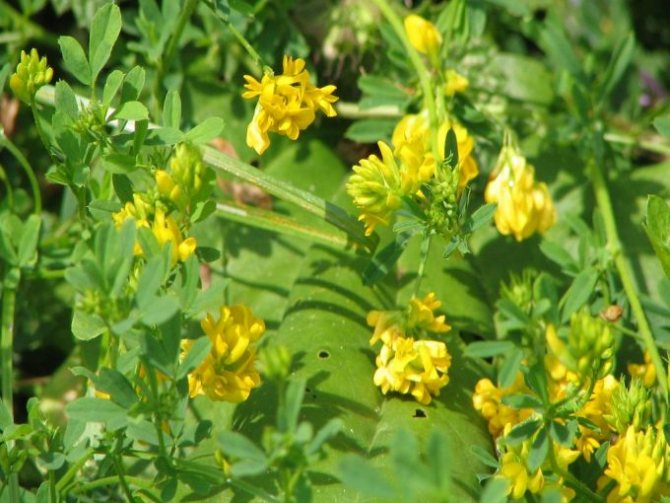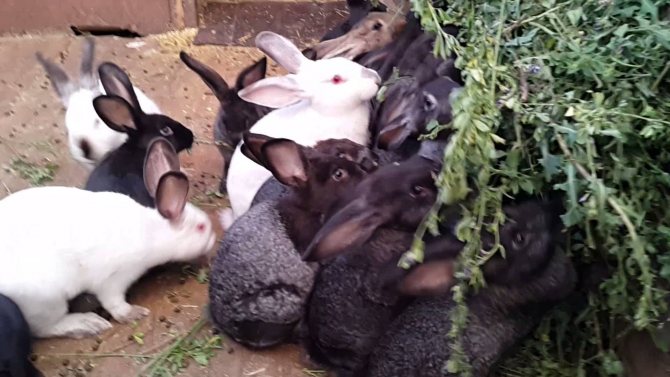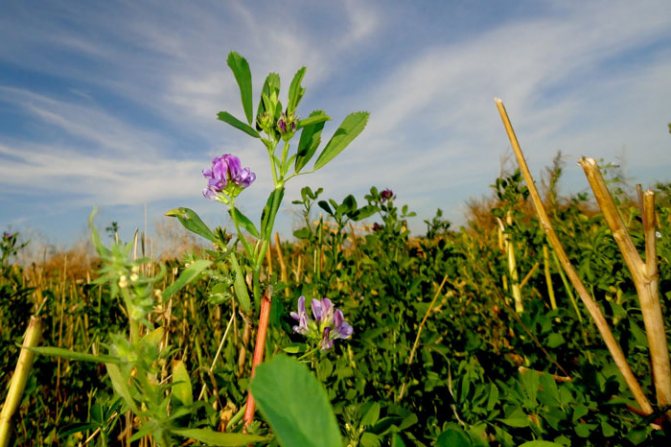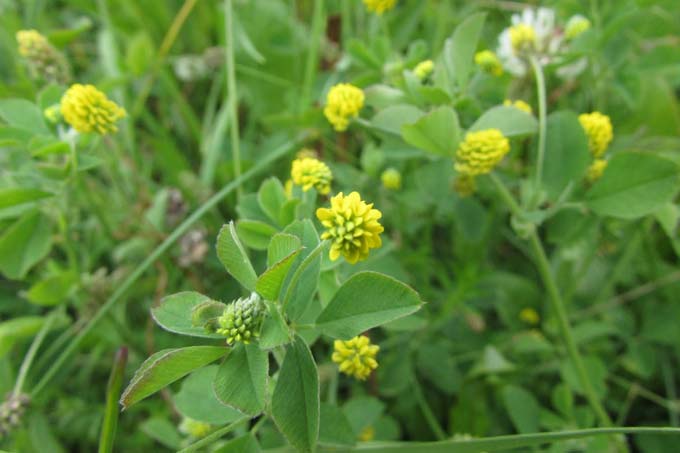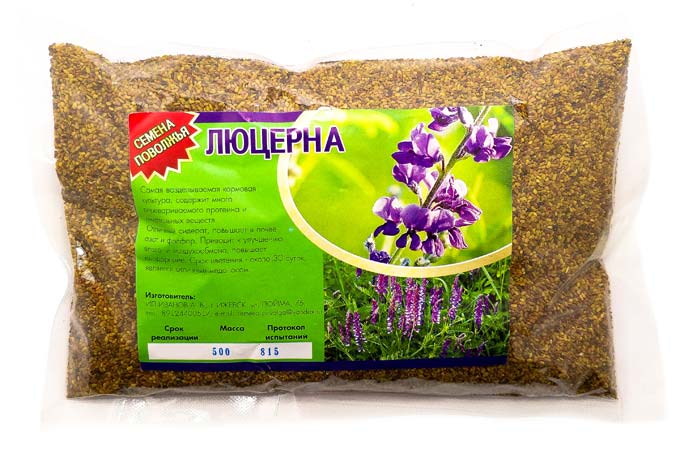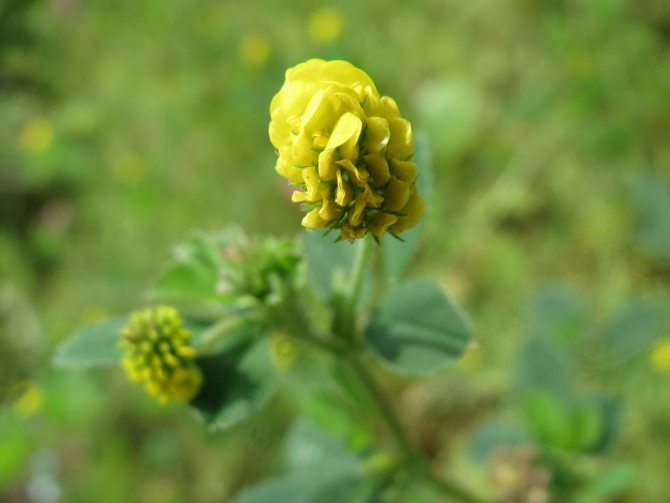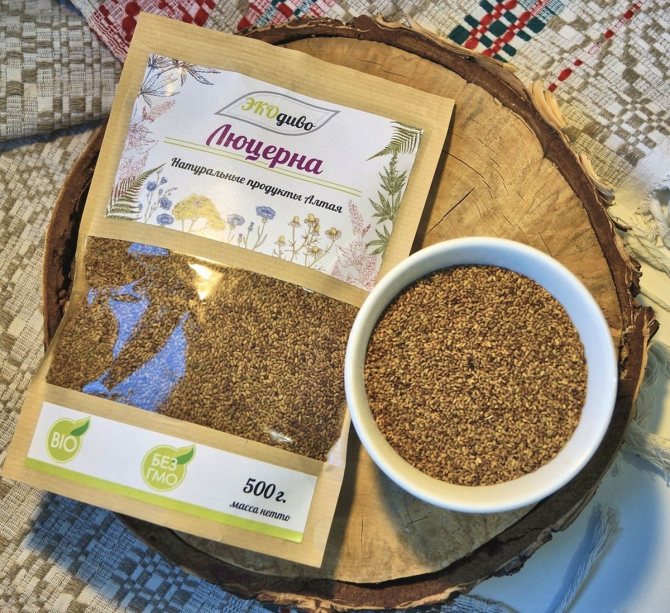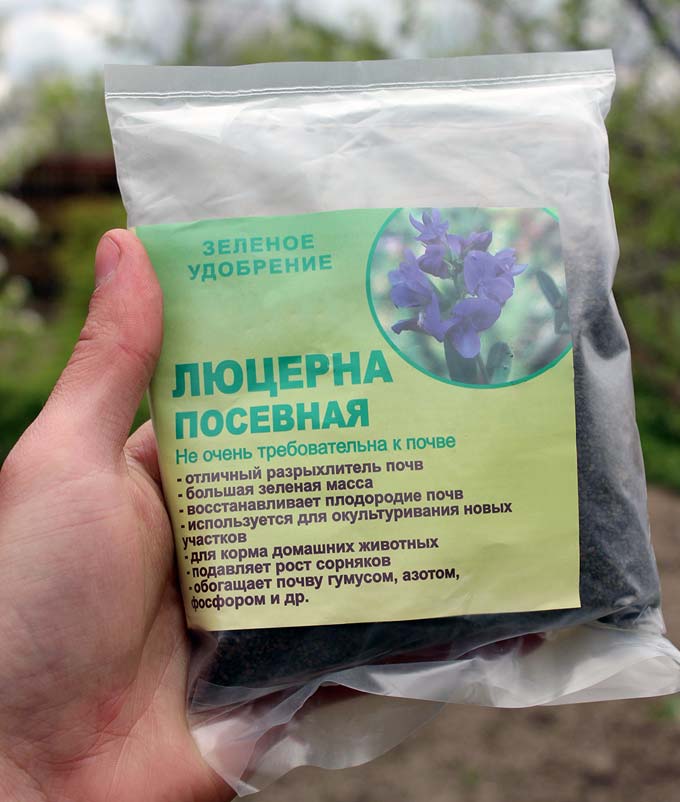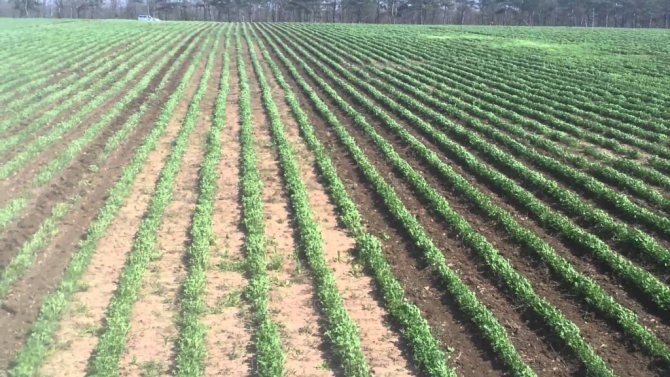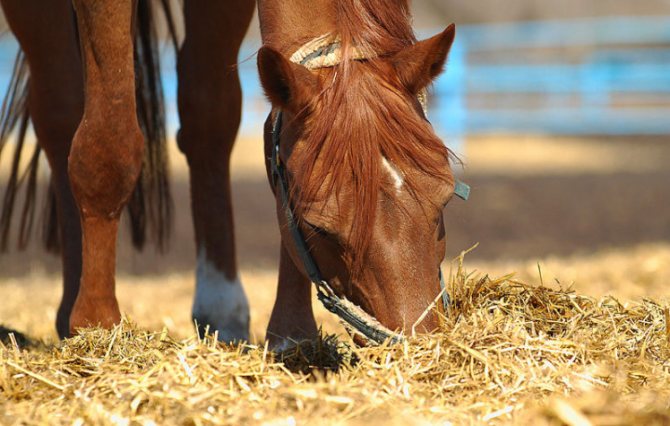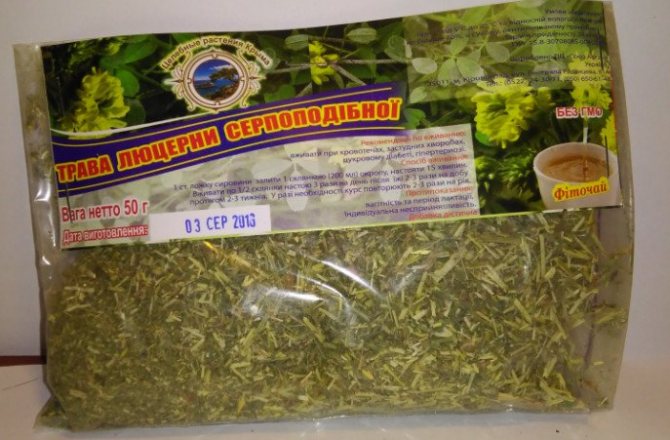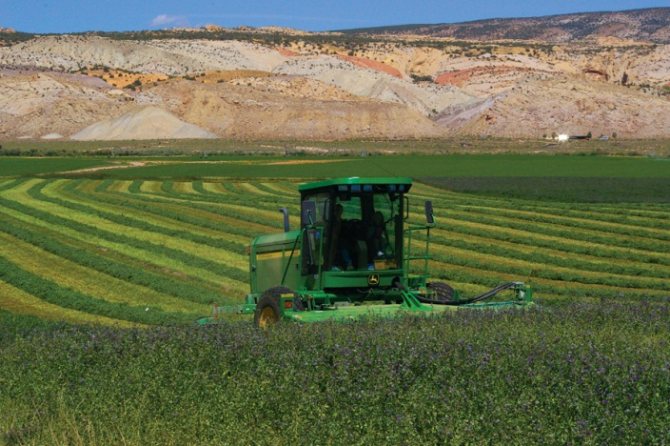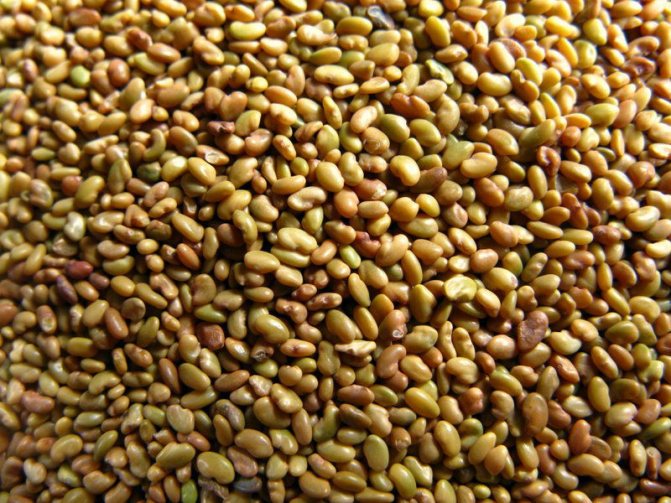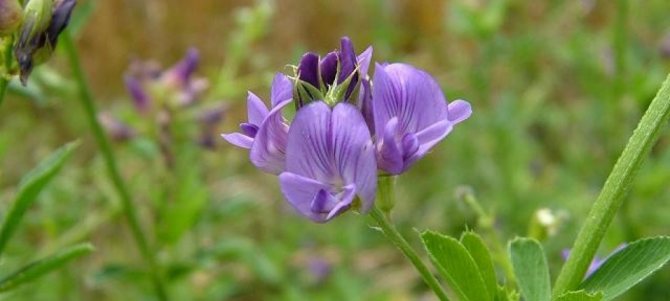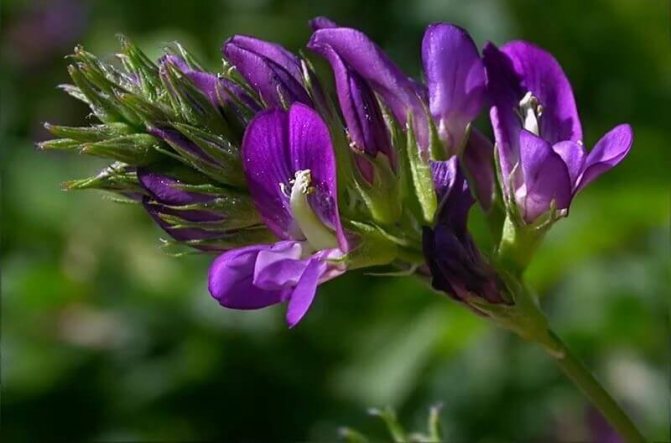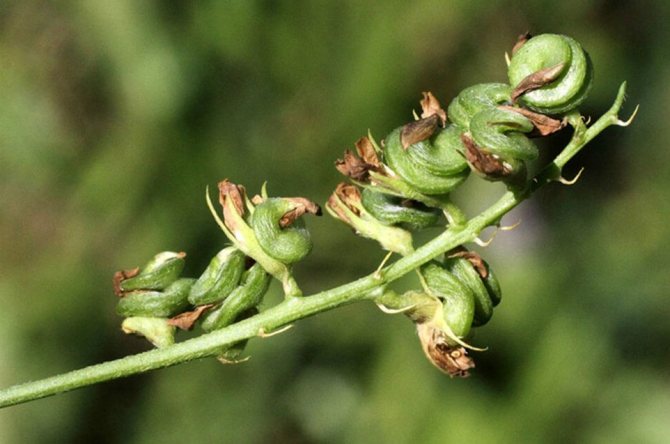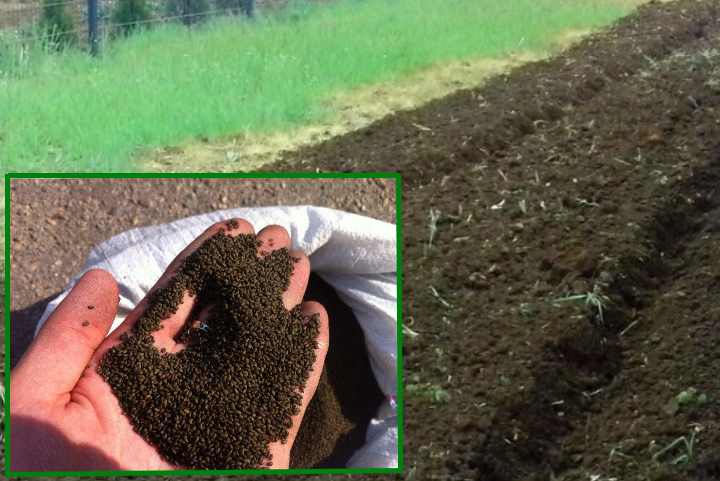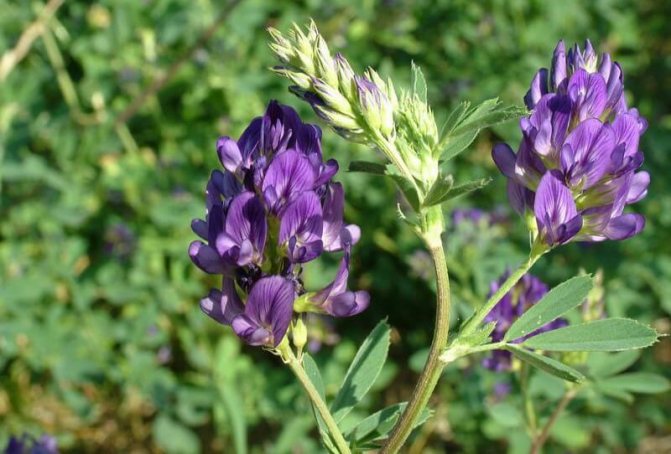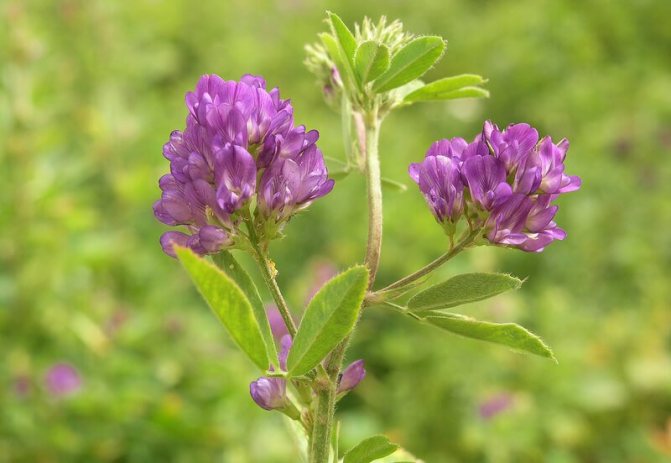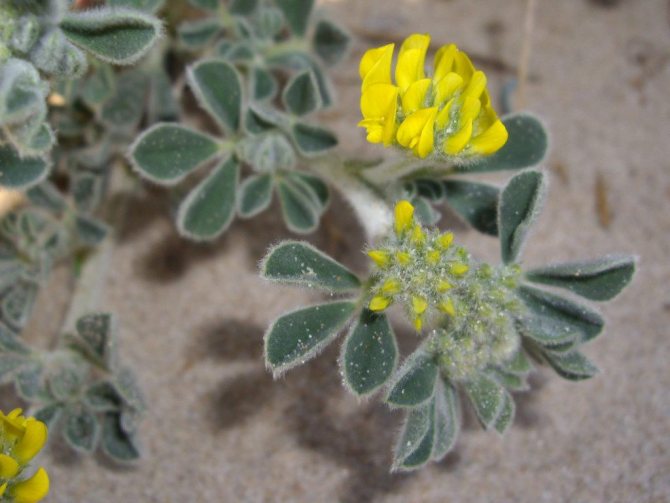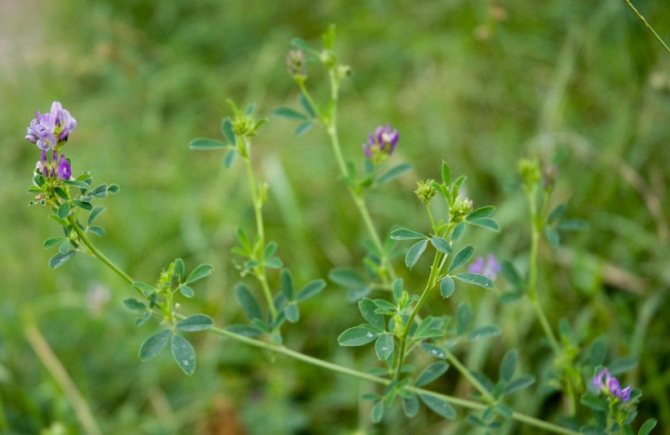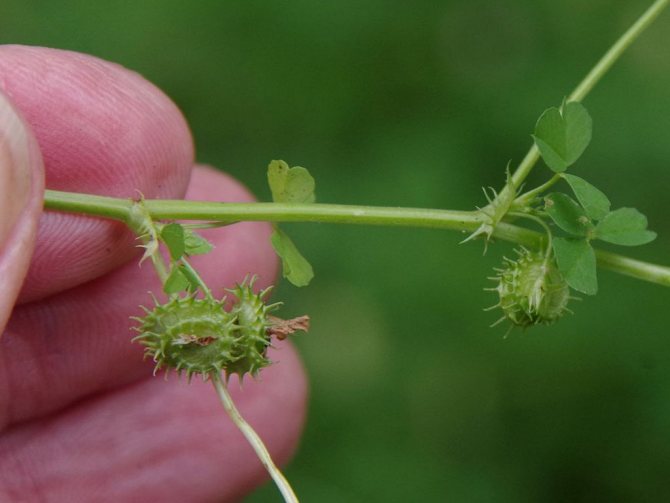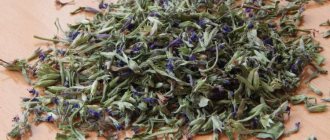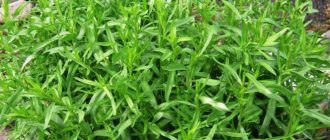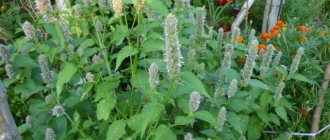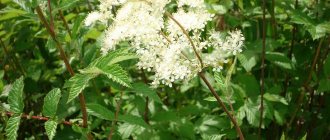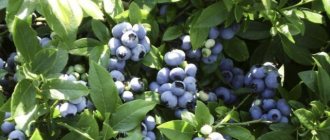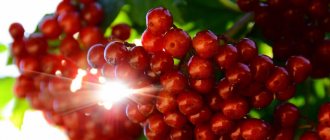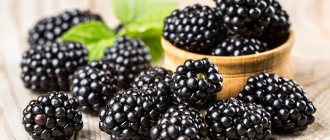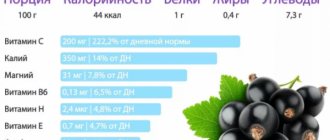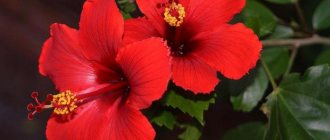Alfalfa description
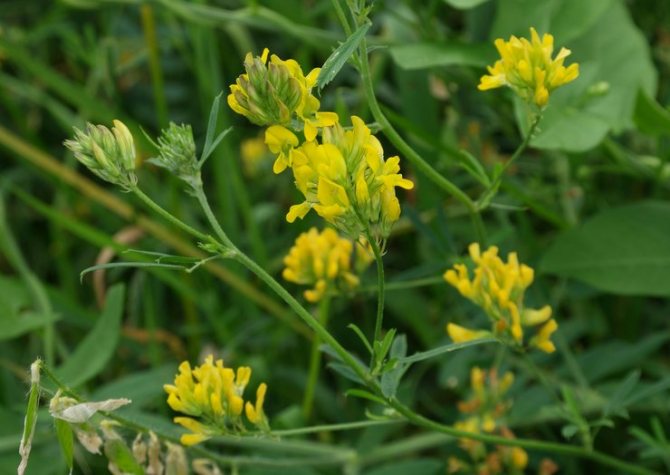
Alfalfa has both annual and perennial species. The stems begin to branch from the very base or at the top, forming a low-growing branched shrub. The rhizome is quite dense and strong, capable of penetrating the ground to a great depth and contains a network of lateral layers. They accumulate useful substances that are difficult to extract for plants with superficial rhizomes. Some representatives of the genus have basal shoots located in a horizontal direction. Since alfalfa belongs to the legume group, its roots are also covered with nodules, where nitrogen-fixing bacteria live. The function of bacteria is to recycle nitrogen and enrich the soil with nutrients.
The shoots are strewn with petiolate leaves, which are connected individually into rounded rosettes. Each leaf is attached to a separate petiole. The central segment looks longer against the background of the rest of the leaves. The edges are jagged. From the inside, the plates are covered with a short nap.
Closer to the top of the bush, inflorescences-brushes or capitate buds in the form of a cylinder open on the shoots. The size of the flowers is from 1.5 to 8 cm. Corollas are formed from petals and outwardly resemble a sailboat or a moth. From below, the petals grow together. Inflorescences are held on long pedicels with pistils and stamens. First, the buds bloom at the bottom of the peduncle. The color of alfalfa is predominantly blue, purple or yellow. However, there are also hybrid varieties with variegated colors. The budding process occurs two months after the alfalfa seeds have been in the soil, and continues for 3 or 4 weeks. One cluster blooms for about 10 days. Every day 3-5 fresh buds are born.
The flowers are pollinated by insects. In place of pollinated buds, beans are formed, painted in a brown or brown tone. The fruit is shaped like a month or a spiral. The bean cavity is filled with small yellow or brownish bean-like seeds. The seed skin is dense, poorly permeable to moisture.
Recipes
1 To strengthen vitalityIt is recommended to add sprouted alfalfa seeds to the diet to increase energy. The seeds are washed under running water. Spread on gauze or cotton cloth. Sprinkle well with water so that the cloth remains damp. As it dries, the fabric is re-moistened. These actions are carried out before the first appearance of shoots. You need to eat from 1 to 2 teaspoons of crushed sprouts per day. It is recommended to add to fresh vegetable salad, porridge and main courses.
2 To normalize blood glucose levels... To prepare the broth, you need to combine 4 tsp. dry herbs and 500 ml of boiling water. Put in a water bath, warm up for 30 minutes. Remove, cover and leave to infuse for 60 minutes. Filter, take the broth within 2 days, dividing the intake into equal time intervals. It is important to keep your blood sugar under control.
3 With hormonal imbalance in 600 ml of boiling water, add 4 tbsp. dry grass. Put the container with the contents on the stove, boil for 10 minutes. Pour into a thermos, close and leave for 3-4 hours. Strain, take half a glass three times a day.
Planting alfalfa
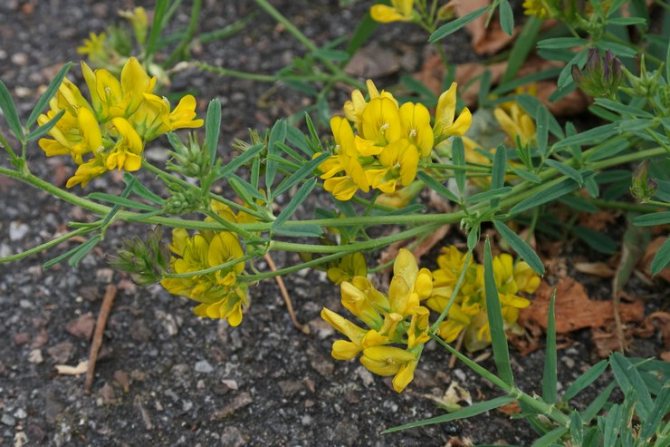

It is recommended to plant alfalfa by sowing. The seeds are sent to the soil in March, when the first agricultural work begins. The site is dug up in advance, the soil is sprinkled with lime and watered. Before sowing, the material is stratified and treated with special preparations that will help protect plants from infectious diseases. Sowing alfalfa seeds is done in rows. The sowing depth should be no more than 1.5 cm. For even distribution of seeds, they are pre-mixed with sand.
Gardeners also plant alfalfa next to cereal plants, but be prepared for the fact that the bushes begin to lack sunlight. As a result, the grass will begin to grow more slowly, and the number of seeds will be halved. The best growth of alfalfa is observed if sowing is organized in rows with an interval of at least 45 cm, then pollination will occur much more efficiently.
Beet planters are used to sow large areas of alfalfa for the purpose of growing forage. If you want to grow several bushes of grass in your garden, you can manually scatter alfalfa seeds. The main thing is to prevent the soil from drying out and maintain a sufficient level of moisture in the root zone.
How is it used in cosmetology
In cosmetology, alfalfa has gained popularity due to its anti-aging properties for the skin of the face. It is able to relieve puffiness and redness, improve complexion. The herb also has an excellent effect on hair growth, prevents hair loss.
For hair
The herb infusion has a positive effect on the scalp. It is applied to the hair after washing, rubbed into the skin. For cooking: 4 tablespoons of herbs in 1 liter of water. Boil for 10 minutes and leave to cool, after which you can use. You can also consume alfalfa juice internally. Drinking fresh juice several times a week, you will certainly see changes in the condition of your hair. They will drop out less and begin to grow actively.
For the beauty of hair, it is recommended to use clove oil, cinnamon, bergamot, mustard, rosemary, chili pepper, burdock root.
For face and body skin
Alfalfa has a positive effect on the complexion, relieves redness and puffiness, has a rejuvenating effect, tightening small wrinkles and evening out skin tone. For this, it is advised to make masks based on herbs.
Anti-redness mask
Mix the decoction of dried herbs with honey and apply on the face, avoiding the area around the eyes. Leave the mask for 15-20 minutes and then remove with a damp towel or rinse with warm water.
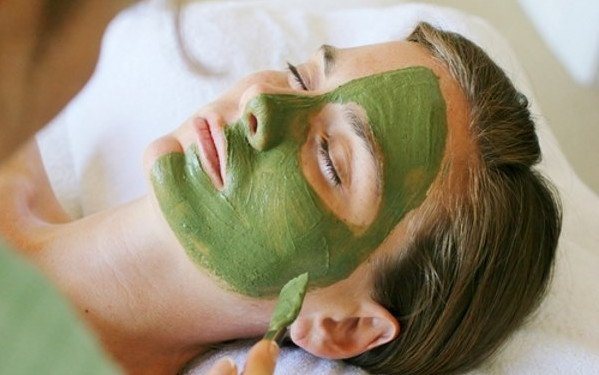

Anti-aging mask
Grind the dried alfalfa herb to a powder using a coffee grinder or blender. Take 1 tbsp. chopped material and add boiling water until a thick, mushy consistency is formed. Let the mixture brew a little, and then add honey to it and mix well again. The resulting mask can be applied to the face for 10 minutes. At the end of the time, it should be washed off and applied with a moisturizer. You can take such a cosmetic procedure no more than 2 times a week.
Check out the useful properties of the varieties of honey: linden, acacia, chestnut, buckwheat, May, sunflower, fireweed, mountain.
Alfalfa rejuvenating mask
In addition to the infusion, the juice of freshly harvested grass also demonstrates an effective result. To prepare the mask, you will need 1 tsp. juice and the same amount of liquid honey. After mixing the ingredients, the mixture is applied to the face and neck area for 20 minutes, and then washed off. You can apply such procedures every other day, in a course of 10 sessions, and then you will be able to observe the visible effect of natural cosmetics.
Growing alfalfa
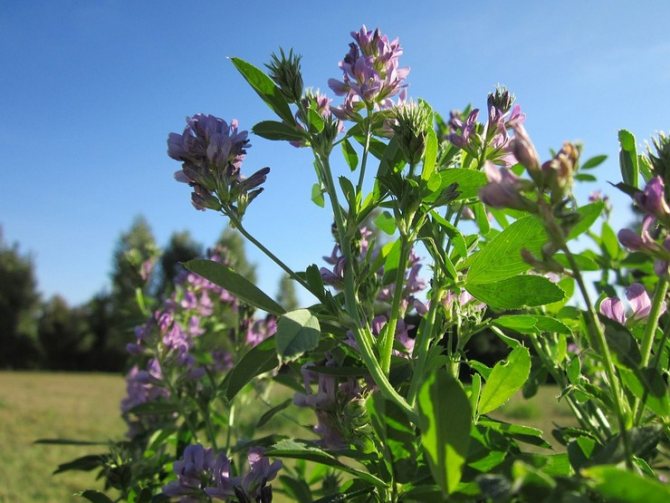

Growing alfalfa is easy for gardeners. Bushes prefer lighted areas. The shade gives undersized and underdeveloped growth.The substrate is selected nourishing and permeable air, which has a neutral or slightly alkaline environment. Loamy soil types are most suitable for grass, and salt marshes, rocky embankments and heavy clay structures, where groundwater is close, have a bad effect on its growth. In such an environment, nodule bacteria are unlikely to be able to multiply.
A short drought practically does not harm the plant, however, too dry soil, without regular irrigation, will soon lead to the death and drying out of the roots. Conversely, excess moisture contributes to the development of powdery mildew. The grass is especially sensitive to moisture in the first years of life.
The optimum temperature for growing alfalfa is + 22 ... + 30 ° C. The plant can withstand periods of sweltering heat. Some varieties of alfalfa are able to survive even in deep frosts in the northernmost regions of the planet.
Young growth is required to be protected from weeds. The site is periodically loosened and hilled.
If alfalfa is intended for forage purposes, the grass is cut as it grows. For the first time, when budding occurs, and repeat when the plant is actively blooming. Mowing is almost painless. In a month or a month and a half, the culture again pleases with flowers. To prevent the grass from lodging, the roots are trimmed horizontally using special tools. We are talking about cultivators and flat cutters.
Occasionally, alfalfa is susceptible to fungal infections. Bordeaux liquid helps to stop the spread of the disease. Dangerous parasites that pose a serious threat are the weevil, the alfalfa bug, and the thickfoot. Insecticidal preparations allow to cope with them.
As a siderat, alfalfa is used both in household plots and in field lands. The herb is considered a highly productive fertilizer. The plant annually provides from 8 to 10 mows and grows about 120 tons of green mass from one hectare of land. Thanks to the vital activity of the culture, the soil is enriched with nitrogen. If a humid microclimate prevails on the site, the biomass decomposes on its own, which improves the composition of the soil and reduces acidity.
Description of the plant, its types
Alfalfa is a perennial that is intended as a seed crop and belongs to the legume family. In nature, alfalfa can be found as a wild plant, which is generally completely unpretentious and not demanding in terms of grooming procedures and agricultural practices. The root system of alfalfa is very strong and thick, the roots lie deep enough in the soil, so you should make sure that watering is effective. The stem of the plant is straight, stable, covered from bottom to top with a large number of leaves, which are planted rather densely. The stem height usually reaches 85 centimeters, no more. Inflorescences can have blue and blue hues, they are collected in not very large tassels. Flowering usually occurs in the summer. As for the fruits that grow on the bushes, these are usually hooked beans, which finally ripen completely around August.
In general, alfalfa is a plant whose homeland is considered to be the Asian continent. In wild, natural conditions, the plant can most often be found in the Balkans and in different regions of Russia. In particular, alfalfa loves to grow near water bodies, as well as on forest edges and meadows. Initially, alfalfa was intended as a fodder base for livestock, and in general, this remains its most basic purpose. The horticultural culture has been around since the sixth century and was planted abundantly to be mowed for horse feed.Over time, the fodder crop began to be used by many other animals, and gardeners began to plant alfalfa in even greater quantities, as this plant seemed to them incredibly attractive, unpretentious and very effective.
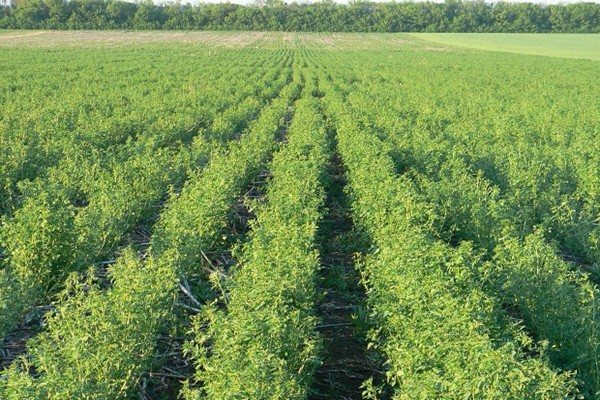

Alfalfa can be considered both as a cultivated plant and as a wild species. In both cases, there are about a hundred varieties of alfalfa, which are known today and are quite popular. In the wild, the plant is found tall, its height can reach one meter. If alfalfa is grown in agriculture, then it is used as fodder material for birds and livestock, but alfalfa can also differ in that it has a huge number of useful and nutritious properties for the person himself. Alfalfa becomes a component of biologically active additives (dietary supplements), and is also included in homeopathic medicines and cosmetic products, which are now used almost everywhere in the world, for which alfalfa has received even greater recognition.
Of course, it is worth mentioning that alfalfa has numerous species, each of which has its own special characteristics and properties, and the following varieties stand out today:
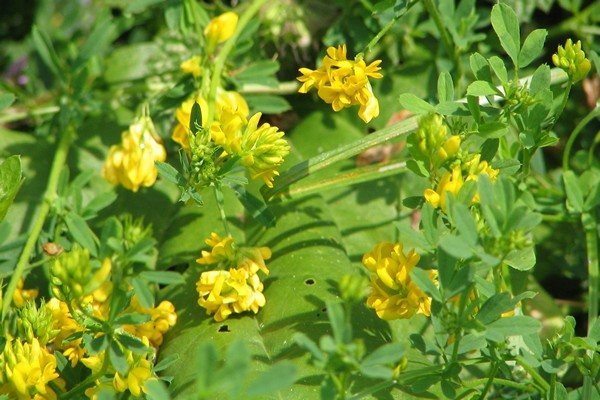

- sickle alfalfa Is a yellow species of alfalfa. It grows in the form of a tall and erect plant, and this alfalfa got its name just due to the color of its inflorescences. The culture can bloom with very small flowers, which are painted in an attractive yellow shade, the flowers are collected in tassels. As for the fodder productivity of this type of alfalfa, it is at an average level, in general, the cuttings are not so productive, although this variety is still very popular due to the fact that the plant is completely unpretentious and very useful, even in small quantities.
- hop-like type of alfalfa - this plant is of medium stature, while the stem is erect, the end of flowering is the formation of pods of a dark, almost black color, seeds are located inside the pods. This species is used mainly in order to make up the fodder base of agricultural livestock, which at the same time receive a sufficient amount of not only nutrition, but also nutrients and vitamins, which are just contained in hop alfalfa
- blue alfalfa - it also includes several well-known and widespread subspecies of plants - Caucasian, Central Asian and Indian alfalfa, as well as subspecies such as European and Mediterranean species of alfalfa, which have their own characteristics and characteristics. What unites all these subspecies is that they are winter-hardy and frost-resistant, grow incredibly quickly, you can carry out not one, but several mows at once, each of which will be equally useful and effective in what alfalfa is originally intended for.
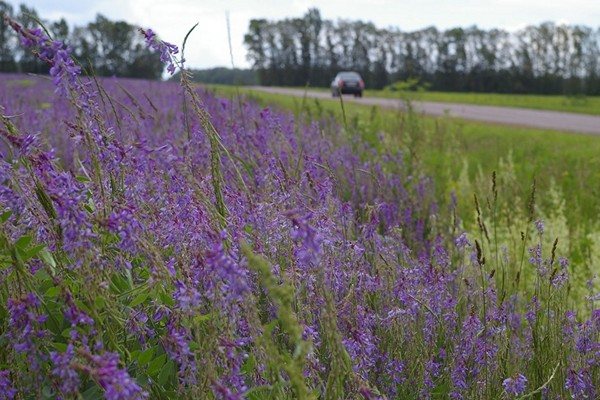

Variable species of alfalfa Is another species that we will consider in the framework of this article. It is a very resistant plant when compared to many other types and varieties of alfalfa. During the growing season, this species is able to give not one, or even two cuts, but three full cuts, which are really incredibly useful and interesting. Of all the species, it is the changeable alfalfa that is considered the most productive, it perfectly tolerates dry periods, sudden temperature changes, lower temperatures, without losing its properties and yield. I would also like to touch upon the northern species of alfalfa - this species perfectly tolerates lower temperatures and frost, and also perfectly takes root in swampy soils, which cannot be said about many other varieties and types of alfalfa.This species grows mainly in northern latitudes, settles in the armholes of rivers, next to lakes and reservoirs. It has suckling subspecies, which are also found quite often, and at the same time have their own specifics and features. Any alfalfa is a sowing species that can satisfy certain needs in agriculture.
Alfalfa variety called Sparta - This is a hybrid variety of alfalfa, which was bred by breeders specially. It was obtained thanks to numerous crosses, and as a result, crossing of such varieties as the Slavic variety and the Langensteiner alfalfa variety turned out to be ideal. The variety originates from the blue species of alfalfa, has been planted for agricultural purposes since about the 80s of the 20th century, has already gained special demand and popularity among gardeners and florists, as it has a huge number of advantages. It is an erect, upright plant that can fall down slightly if it reaches its maximum height. Lodging also occurs due to the fact that the bush gradually falls apart, it becomes very heavy. In height, it can reach 95 centimeters, sometimes even a whole meter, if the variety grows in the most favorable and suitable conditions for itself.
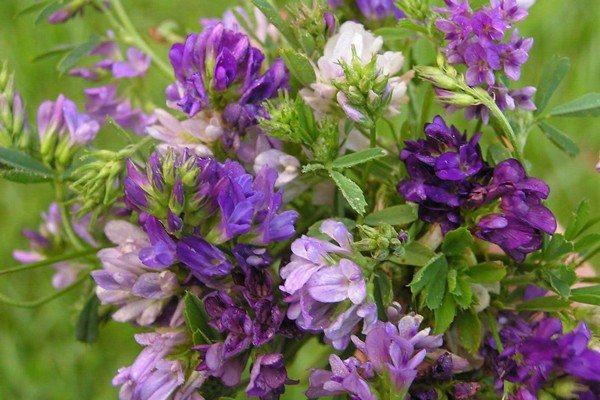

The inflorescences are in the shape of a cylinder, usually collected in tassels that reach one centimeter, the color of the flowers themselves can be of any shade of blue, sometimes there are dark purple or lilac flowers that look quite attractive and, at the same time, rather unusual. The beans are medium in size, hidden in a shell, which is distinguished by its loose texture, but the beans still hold quite tightly there. The root system of this alfalfa variety is very well developed, and therefore, during the growing season, you can get as many as four cuttings, if, of course, you take care of the plant and satisfy its most minimal needs. The green mass of alfalfa grows very quickly; the gardener makes the first cuttings about 75-80 days after the alfalfa was sown in open ground. The varieties contain approximately 22% vegetable protein and are therefore considered one of the most nutritious and popular varieties. It is also worth noting that this variety of alfalfa is completely immune to one of the most dangerous diseases - brown spot: it is not afraid of it, since alfalfa is distinguished by a high level of immunity and stress resistance.
A hybrid variety called Bagheera - was bred in the 80s, and it appeared as a result of long work of breeders on crossing hybrids of blue alfalfa and alfalfa changeable. In height, this variety can reach about one meter, the plant is bushy, has a straight, upright shape, can develop up to forty stems, which differ in thickness and incredible strength. The leaves of the variety are rounded, of a light green hue, they look very bright and attractive. The inflorescences of the bush are very dense, painted in a blue tint, the size of one brush can be about 5.5 centimeters, the beans are also spiral-shaped, colored brown when they reach their maximum maturity. The seeds are green, slightly yellowish in color. The variety as a whole is particularly resistant to the problem of lodging of bushes, and therefore it is from this variety that the highest quality hay can be made. The yield per hectare can reach about 65 tons, and sometimes even more. The dry matter accounts for about 11% of the protein, while the variety is distinguished by its resistance to the development of various diseases, putrefactive formations, and, in principle, it is appreciated by gardeners and gardeners, those who raise livestock, and it should be in a constant search for materials to feed animals.
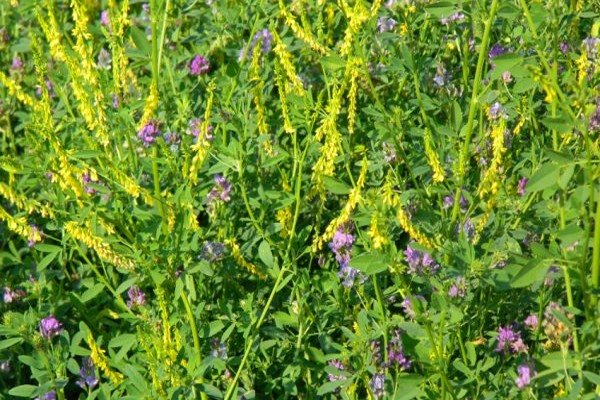

Fairy alfalfa - this variety was bred by domestic breeders who strove to obtain a high-yielding alfalfa that would yield an excellent harvest even in not the most favorable conditions. The cultivar was later classified as a blue hybrid variable alfalfa, but it still has a large number of features and characteristics that indicate that this alfalfa is unique. This cultivar has inherited many positive characteristics from its parents. It is quite resistant to sudden changes in temperature, while it perfectly tolerates short-term droughts, if they suddenly happen. The variety has been grown recently - since about 2011, and due to the fact that it has a huge number of positive traits and characteristics, it is very common in various regions of Russia, especially in the south.
The stems of the plant are very strong, even a little rough. They are entirely covered with small leaves, sometimes the height can reach one and a half meters. Flowering is carried out by delicate purple flowers, the inflorescences are in the form of a cylinder. The seeds are yellow, thrown away on their own, so this variety belongs to self-sowing. For some, this is an advantage, and some gardeners see this as a significant disadvantage of this variety, so it is worth thinking about before planting this particular alfalfa. Alfalfa can be mowed even during the period of active budding. During the entire growing season of this variety, three bevels can be carried out, no more, and the yield is approximately 62 tons of alfalfa per hectare of plantings. The choice of the type and variety of alfalfa entirely depends on what the gardener himself would like to achieve, and depends on his personal capabilities in growing this or that variety or species, so gardeners and florists never give specific recommendations on this particular occasion.
Alfalfa is usually sown in the spring, when the soil is already sufficiently warmed up and saturated with moisture. Much will also depend on the region in which alfalfa is sown, and the planting time will depend on this. As a rule, universally alfalfa is sown in open ground already in April, so we can say that this time is suitable for any varieties and types of alfalfa in order for the gardener to get a decent harvest, it is necessary to take care of preparing the seeds for sowing in the open in advance. priming. Since the seeds have a fairly dense shell, it is worth treating them mechanically before sowing. To do this, the seeds are removed from the top layer, and also ground with river sand.
If alfalfa is sown in too small areas, then the seeds should first be soaked in water and then dried. After drying, the seeds are treated with special substances - these are pesticides, which are calculated as 3.5 kilograms of the drug per ton of seeds, and from here it is worth starting from calculating the correct dosage. In order for the germination of seeds to be much higher, it is also recommended to treat the seeds with sodium molybdenum, since it is considered one of the most suitable for this crop. Alfalfa can react very capriciously to its predecessors, and it takes root best in the area where previously row crops or crops belonging to leguminous families grew. Alfalfa is also an excellent predecessor when it comes to the many plants that grow in agriculture.
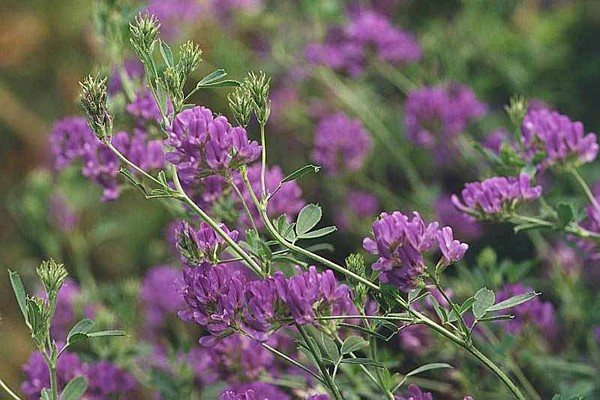

In order for the harvest to be as successful and abundant as possible, it is necessary to correctly process the arable land just before sowing the plants. Prepare the site in advance, for this it should be very carefully inspected, get rid of weeds and other vegetation, and also harrow the ground. With the help of plowing, it is necessary to remove very large and heavy clods of earth, as this will make the soil looser, it will be better enriched with oxygen and moisture.Alfalfa thrives on rich and fertile soils, and if the plant grows on such soils, then you can get about four mows in one season. In order to do this, it is recommended to apply organic additives and fertilizers to the soil before sowing alfalfa, and ideally also some mineral mixtures and fertilizers that are perfectly combined with organic ones and provide a comprehensive nutrition to the culture.
Sowing is carried out from the very beginning of the spring period, the seeds are sown using a special device - a seeder, while it is possible to reduce possible losses that relate to both the main and secondary crops of agriculture. In principle, alfalfa can be sown with some auxiliary plants, among which oats and rye stand out. About five million suitable seeds can be planted per hectare and will demonstrate excellent growth and development results. If alfalfa is sown for spring crops, as well as for annuals, then presowing treatment and soil rolling may not be carried out, alfalfa will already feel great in the existing soil composition. You can sow alfalfa using a disc coulter, but it should also be borne in mind that depth stops are extremely important in this case. When alfalfa is sown, the grower uses an ordinary sowing method, leaving about 11-14 centimeters of distance between rows.
You can use a method such as coverless sowing, but at the same time it is used only in those areas of arable land where the gardener has previously used measures and procedures to prevent the occurrence of abundant weeds. It is also worth keeping in mind that maintaining the distance between the rows is very important. If the row spacing is less, this will lead to thickening of the plantings, and can negatively affect the yield of alfalfa itself - it will become much smaller, depleted, and in general the plantings will feel less comfortable in such conditions. If alfalfa is grown to be used as livestock feed, then the row spacing can be slightly reduced to a maximum of 11 centimeters. If alfalfa is grown as a future seed crop, then the row spacing should be about half a meter in order for the stem to develop well under these conditions, and to prevent possible lodging of shrubs, as they can grow very actively. In general, these norms should be observed exactly until the seeds are finally ripe.
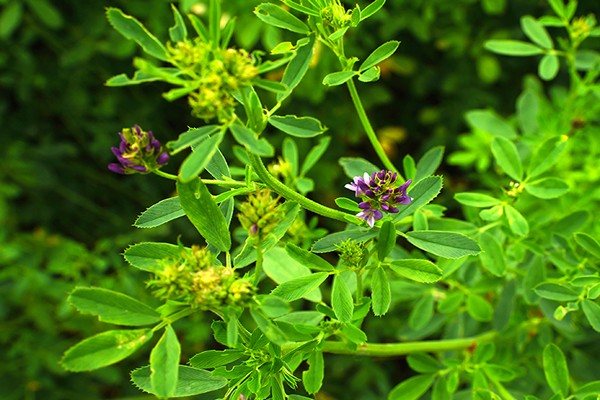

Growing alfalfa as forage grass
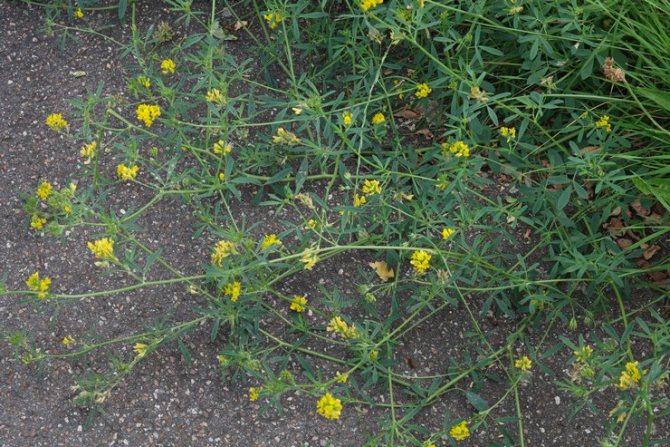

The tissues of alfalfa contain a large amount of protein, amino acids, potassium, phosphorus, which explains its demand in the agricultural industry. Grass is an excellent forage crop for small and large livestock. When the plant is at the budding stage, the nutritional value of the shoots is considered to be maximum. As for the usefulness of the herb, it is better to collect it during the flowering period.
The length of shoots for mowing for forage purposes should be from 8 to 10 cm. Cutting off the shoots at the indicated mark will allow you to quickly restore the green cover in the future. During the year, no more than 3 mows are performed. The harvested raw materials are used as fresh feeding or dried for hay, from which fodder briquettes or granules are made.
Plant care, alfalfa yield
There is no need to take care of the plant specially and spend a lot of time. Let's find out how you can achieve high yields:
- watering - if the summer is dry, the soil must be moistened before germination. If a crust appears, it must be smoothed with a roller or broken. When the first sprouts hatch, there is no need to level the soil with a roller anymore;
- alfalfa rose up to 20 cm in height - it's time to water the culture again. Do not flood the soil, as this can negatively affect its further growth;
- after the buds appear Alfalfa should be mowed, leaving 15 cm and watering again (watering occurs in the last week of June). Pouring is highly undesirable, since the roots of the plant are long and they have enough moisture. Because of this feature, the plant is not afraid of drought;
- as the weeds appear, they need to be removed, since it is impossible to get a good harvest-cut. In some cases, if alfalfa is grown for animal feed, weeds are mowed simultaneously with alfalfa and given to animals immediately or in dried form;
- how many times can a crop be mowed? Everything will depend on the climate in which alfalfa is grown. The first mowing - at the beginning of flowering, the last - 30 days before the first frost;
- third watering - after mowing in September - it is not recommended to overfill the soil. With excessive watering, the plant stops its growth, becomes weak, plantings can thin out;
- collection of seeds: to collect the seeds, you need to leave some of the plants. After flowering, pods with seeds will appear on each trunk.
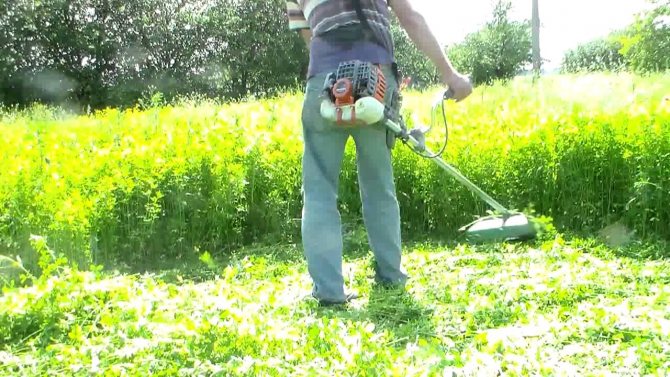

A good harvest of alfalfa can be obtained at the peak of growth - during the flowering period. But if you focus on the quality of the feed, then it is better to collect alfalfa during the budding period at the initial stage.
Types and varieties of alfalfa with photos
There are over a hundred different modification forms of alfalfa. Most of the species grows in Russia.
Crescent alfalfa (Medicago falcata)
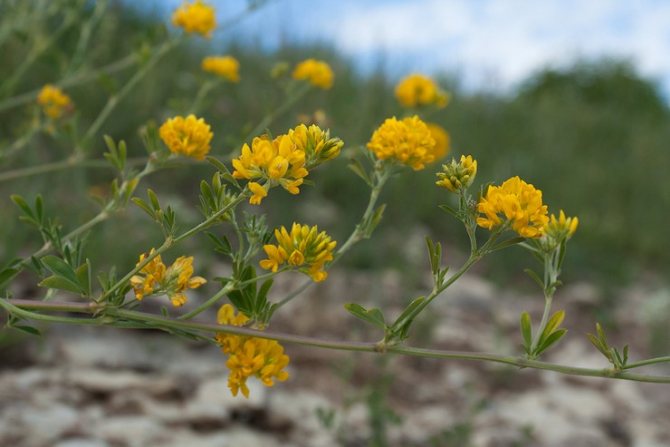

Crescent alfalfa bushes have a well-branched rhizome and basal layers. Plant height is 40-80 cm. The surface of the stems is smooth or covered with fine hair. Oval or lanceolate leaves emerge from the petioles. The size of the plates ranges from 0.5 to 2.2 cm. The capitate inflorescences bloom in early or mid-summer. The brushes are formed from many small buds. Pedicels are low. When the pollination process ends, sickle-shaped beans with a glandular, fleecy bloom are formed. The size of the fruits, depending on the age of the plant, is about 8-12 mm.
Hop alfalfa (Medicago lupulina)
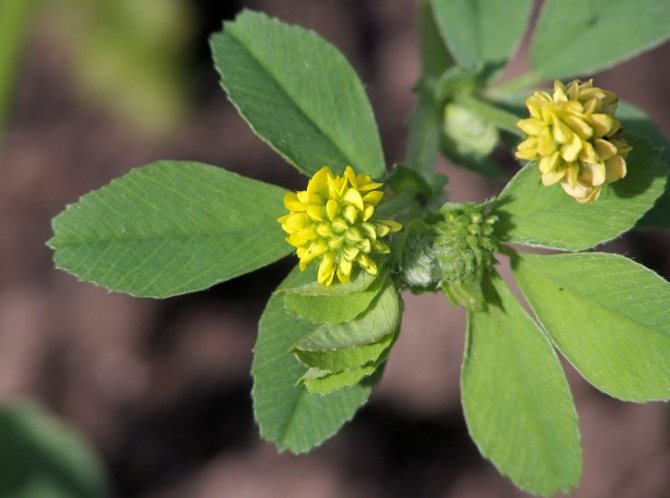

There are both annual and biennial representatives of this type of alfalfa. The rhizome is thinner than that of the previous herb. The height of the stems is from 10 to 50 cm. The leaves are petiolate. Their length does not exceed 15 mm, and the shape resembles small diamonds. The foliage of hop alfalfa has a wedge-shaped beginning and a barely noticeable notch. The outer side of the plate is covered with pile. Flowers of a yellow hue are collected in capitate spikelets. The plant bears fruit with single-seeded beans that look like small buds. The surface of the beans is protected with a nap. As the fruit ripens, the pile disappears.
Sowing alfalfa (Medicago sativa)


The bushes of this alfalfa are very flexible, the crown develops mainly in the upper part. The length of the stems reaches 80 cm. The main root is thickened and strong, the leaves are oval. Peduncles with axillary base contain lush heads of flowering brushes, the length of which is approximately 2-3 cm. The color range of inflorescences is presented in blue and purple tones. Fruits twisted like snail valves grow 6 mm in length.
Hybrid alfalfa (Medicago x varia)
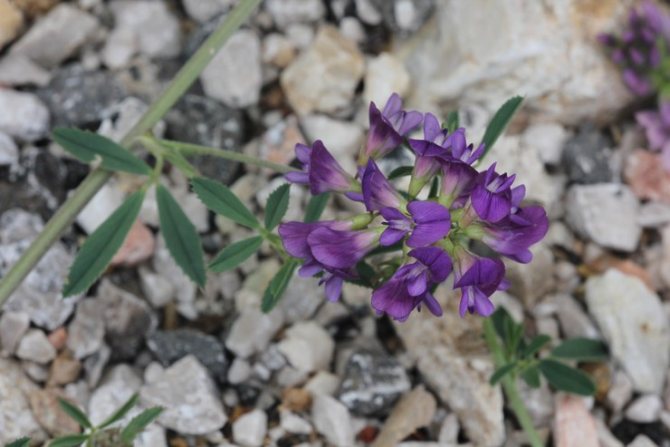

The height of the perennial reaches from 70 to 120 cm. Shoots form a wide spreading crown and are covered with petiolate leaves. The plates are oval, pubescent from the inside with villi. Inflorescences are spherical, growing on pedicels protruding from the axillary leaves. Brushes are friable, from 32 to 5 cm long. The color of inflorescences is variegated or monotonous. There are blue, purple and yellow varieties of hybrid alfalfa. The fruits are larger than regular beans. The skin of the beans is olive or yellow. The shape of the fruit is spiral.
What to sow before and after alfalfa
Alfalfa is a capricious plant towards its predecessors. It will be best if you sow this crop after legumes or row crops. Alfalfa favorably treats such predecessors as spring and winter crops, sugar beets, and silage corn.
Alfalfa itself is a wonderful and beneficial precursor for many valuable crops. In particular, wheat, legumes, oats, and corn grow well after it.
Alfalfa properties
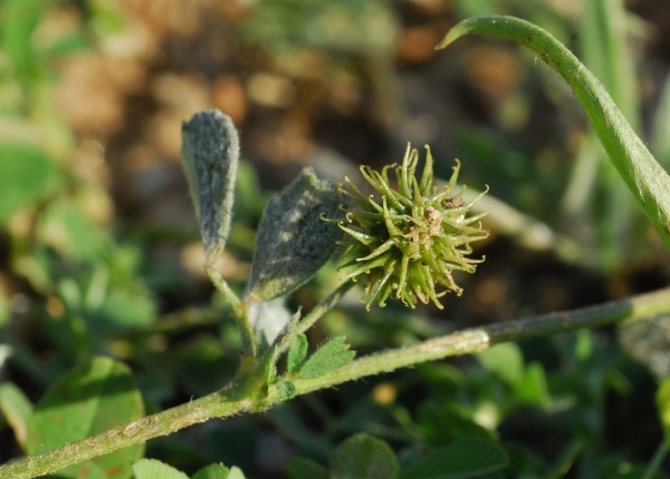

Beneficial features
The plant is rich in various nutrients. Alfalfa has even found its way into Chinese medicine. The herb contains many minerals, vitamins, proteins, phytohormones. The stems, leaves and flowers, which are harvested during the setting of buds or during the flowering process, have medicinal value. The raw materials are dried and poured into cloth bags. On their basis, infusions and decoctions are prepared. Juice obtained from freshly cut alfalfa is considered an effective bioactive supplement. Juice is prescribed to lower cholesterol levels, release excess fluid and stabilize the functioning of the gastrointestinal tract.
The herb alfalfa is used as a folk remedy in the treatment of diabetes mellitus, rheumatism, gout, hepatitis, and diseases related to the endocrine system.
Alfalfa helps to strengthen the body and effectively fights many serious diseases. The plant is recommended for women with hormonal imbalance and uterine fibroids.
Useful properties and contraindications
Alfalfa has been famous for its beneficial properties since ancient times. To this day, it is actively used in folk medicine. In addition, there are medicines based on alfalfa. So what is the use of this plant?
- Alfalfa reduces the risk of heart attacks and strokes. This is due to its ability to lower cholesterol. When alfalfa is consumed, high cholesterol levels return to normal.
- Calcium, ascorbic acid, and B vitamins contained in alfalfa are able to relieve inflammation in tissues and bones. Therefore, the plant is actively used in the treatment of arthritis and arthrosis.
- Alfalfa powder has a beneficial effect on the entire gastrointestinal tract. Stool normalizes, inflammation decreases, intestinal flora is restored. Alfalfa powder is used for colitis, ulcers, gastritis.


- In ancient times, the plant was used to treat open wounds. The protein in the plant is able to stop bleeding. In folk medicine, alfalfa is still used today.
- Alfalfa boosts immunity well. The substances in the plant have antioxidant properties. It is useful for viral infections. The plant removes toxins from the body, improves metabolism.
- Alfalfa is used to treat the genitourinary system. It has a diuretic effect. It removes excess water and salt from the body. Alfalfa also has a beneficial effect on the liver.
- It is believed that substances in alfalfa prevent the formation of cells with mutations. This means that alfalfa is an anticancer plant.
- Alfalfa contains natural estrogen. It has a positive effect on the female body. The regular cycle is restored, the menopause is not so noticeable. The flower is also famous for its ability to treat infertility. This is a very valuable property of alfalfa.
- Alfalfa has a positive effect on the nose and throat. It is used for asthma, sore throat, rhinitis.
- The plant maintains normal pressure. Its properties do not allow the heart to experience heavy stress. The iron in the plant oxygenates the blood. And you start to feel better.
It is interesting! Alfalfa has long been used to remove parasites from the body.
There are not so many contraindications to the use of the plant. The main contraindication is pregnancy and breastfeeding. For lupus, the plant also does not apply. Eating a lot of alfalfa can lead to poisoning.
For treatment, raw germinated seeds are used. But the best option is to purchase ready-made alfalfa powder.
Alfalfa is a popular and very healthy plant. Alfalfa makes up a huge forage base for animals. Its beneficial properties have a positive effect on both humans and animals. No complicated care required. And the plant looks pleasant. Many growers grow alfalfa in their greenhouses, gardens and even potted homes. The main reason for growing alfalfa is its healing properties.
Landing methods and options
Preparing the soil and seeds for planting is an important point. But to obtain the desired result, namely high yields and increased activity as a fertilizer, you should choose the appropriate method and time of planting. In any case, the soil is moistened for better survival.


Under cover
This method is considered the best for northern regions and in places with high humidity. Objectives: obtaining additional products, eliminating problems with weed overgrowing.
The method provides for the protection of alfalfa during the first months, since the sprouts are very weak. The harvest is also small. But you can compensate by combining it with vetch during planting or planting with an oat-pea mixture. Basically, covering is sowing two or more types of plants.
The planting of alfalfa with cereals (winter wheat) is not beneficial. Noble shoots quickly clog young leguminous shoots. Sowing with rump (100 sq. M. = 100 g of seed), timothy (20 g per hundred square meters) is recommended.
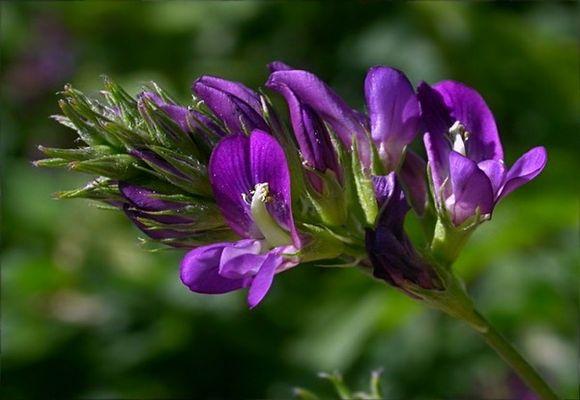

It is possible to calculate the seeding rates for the covered method only after taking into account the climatic conditions. If the humidity in the region is increased or the field is irrigated artificially, then up to 160 g of alfalfa is consumed. In dry climates - 70-80 g.
Bareless option
After the preparation of the earthen plot, regardless of per hectare or one hundred square meters, sowing takes place, soil preparation is provided for in the autumn period.
Further, seeds are scattered manually (if the area is small) or using machinery. Used 2 techniques: along the ridge and across. Seeding rate per one hundred square meters: from 100 to 150 g.
The ways
With the cover method, alfalfa is combined with another type of crop. This helps you get results quickly with a minimum of effort. But without a cover, the option is more difficult. After all, such a combination does not happen.
To compensate for the lack of loss of small alfalfa seeds, experts add sawdust, soil or sand to the seed material. Then they are scattered in fan-shaped movements over the site.
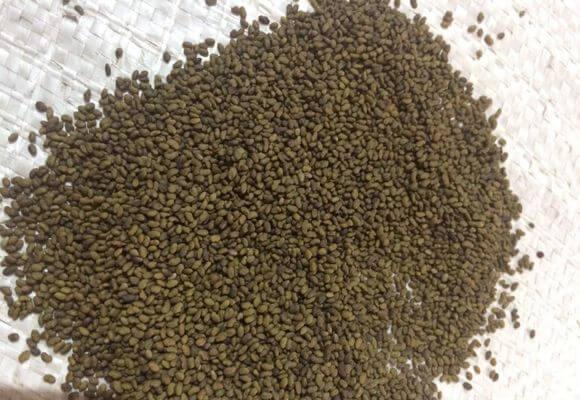

The direction should be one way. It has been used for many years and does not misfire. The purpose (animal feed or fertilizer) does not matter.

